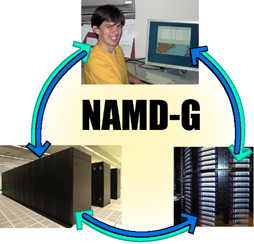Highlights of our Work
2024 | 2023 | 2022 | 2021 | 2020 | 2019 | 2018 | 2017 | 2016 | 2015 | 2014 | 2013 | 2012 | 2011 | 2010 | 2009 | 2008 | 2007 | 2006 | 2005 | 2004 | 2003 | 2002 | 2001
Many proteins store gases like oxygen, carbon dioxide, and nitric oxide,
or react with them. The gases are conducted into the protein through
access routes that exist only in passing and as a result of a
protein's fluctuations. Accordingly, access routes are difficult to
establish, but researchers are now able to image gas access pathways
inside proteins computationally.
The new method
has many implications for biotechnology and science (see
our hydrogenase page and Sep 2005 highlight,
"Hydrogen Fuel from Protein").
Imaging gas
access systematically over whole protein families, e.g., the family
of myoglobins, requires a large number of calculations that need to
be run and monitored. The traditional means of doing so is very
wasteful of the researchers' time.
To solve this problem, NAMD-G, a grid-based automation engine for biomolecular
simulations running the NAMD software, has
been developed in a collaboration with the
National Center for Supercomputing
Applications (see recent
paper).
From the researchers' workstations, NAMD-G "farms out" a large number of
calculations, in parallel, to
supercomputers on the TeraGrid.
NAMD-G monitors and manages multiple sequences of calculations at
distant sites, and performs the necessary data transfers and backups
on an as-needed basis.
While the gas transport simulations provide a clear scientific driver for
the development, NAMD-G is quite general and will aid any NAMD user with
access to the TeraGrid.
The result? Less time spent baby-sitting runs and more time for science.




